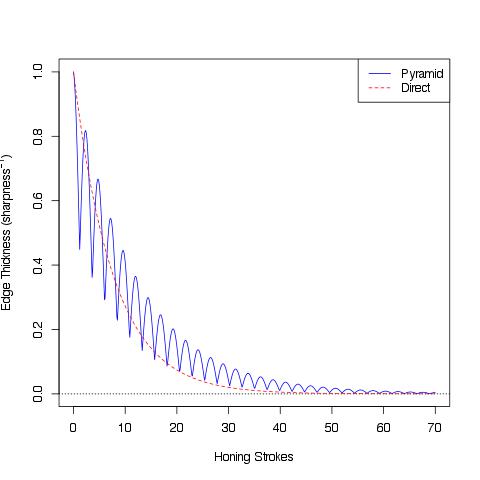Results 1 to 10 of 23
Thread: Sharpening Pyramid question
-
11-02-2012, 10:31 AM #1Senior Member

- Join Date
- Nov 2012
- Location
- Seattle,WA.
- Posts
- 579
Thanked: 55 Sharpening Pyramid question
Sharpening Pyramid question
I don't get the logic behind the sharpening pyramid? Why go from a higher grit to a lower grit?
When you do that aren't you just negating all the work done with the higher grit?
I understand going back to a lower grit if you decide that you left it prematurely (through trial and error) but to plan on going back and forth...what is the logic behind that?
(Edit) Sorry I just noticed that there is a "Honing" section as opposed to this section on "Hones".
-
11-02-2012, 11:09 AM #2

If you check the honing section in the Library, you'll find it refers to the "theory" behind the Pyramid method of honing, then goes on to discuss practice instead of theory. Whatever the theory may be, Pyramid honing is helpful for people who are beginning to hone and have no set method for doing it. I've tried it, and it works, but I much prefer going through natural stone progressions because I have learned through practice when the time to transition from stone to stone has come. For those who lack experience, the Pyramid method is a place to start.
-
11-02-2012, 11:22 AM #3Senior Member

- Join Date
- Nov 2012
- Location
- Seattle,WA.
- Posts
- 579
Thanked: 55
I looked but couldn't find an explanation of why going back in grit was better than staying there in the first place.
-
11-02-2012, 11:43 AM #4

The reason is that going from grit to grit for new people is a tough call. They are often not sure when to make the transition. The Pyramid method eliminates that problem with a set method of essentially not having to concern yourself with when to make those transitions.
-
11-02-2012, 01:17 PM #5
 Sharpening Pyramid question
Sharpening Pyramid question
If I use a pyramid I usually have the blade on a magnet pointing east. Guess you can place it all on a hone for grit but then you may have to 'true' it.
-
11-02-2012, 01:46 PM #6Historically Inquisitive



- Join Date
- Aug 2011
- Location
- Upstate New York
- Posts
- 5,782
- Blog Entries
- 1
Thanked: 4249
It makes the transition between sharpening VS polishing foolproof, you sharpen on 4k, you polish on 8k,with less sharpening and more polishing down the pyramid to obtain a nice 8k edge. If you know how to set a bevel correctly and follow the pyramid you will get a good shaving edge.
And down the road move to other more refine naturals or synthetic, without that good shaving edge all the honing on higher grit stone will be absolutely useless.
-
11-02-2012, 03:52 PM #7At this point in time...




- Join Date
- Jun 2007
- Location
- North Idaho Redoubt
- Posts
- 27,105
- Blog Entries
- 1
Thanked: 13249
When you begin honing razors, the trick is learning to "Sneak" up on the edge..
Every other type of sharpening is only concerned with Sharp, with razors you have to have Sharp and Smooth, so the ability to sneak up on the max potential of the edge is important to learn... The Pyramid teaches that very well... Once you learn that. you can take many other directions to sharp and smooth, but for new Straight Razor honers it is a good tool... In fact it is such a good tool that many very experienced honers still use it for their edges, even though they have the skills to move to other systems...
Mod Edit: Moved to Honing
Last edited by gssixgun; 11-02-2012 at 03:57 PM.
-
The Following User Says Thank You to gssixgun For This Useful Post:
KenWeir (11-07-2012)
-
11-02-2012, 04:44 PM #8

I once asked Lynn about pyramids and among other things he said (paraphrasing) .... I don't know why it works but I know that it does .....
Here is a bunch of stuff on honing by Lynn out of the SRP library
Lynn Abrams On Honing - Straight Razor Place Wiki
-
11-02-2012, 08:47 PM #9There is no charge for Awesomeness



- Join Date
- Aug 2006
- Location
- Maleny, Australia
- Posts
- 7,977
- Blog Entries
- 3
Thanked: 1587
I'm not entirely sure this is absolutely correct or useful to be honest, but here's how I visualise the pyramid technique compared to the "direct" approach.

Perhaps the y axis should be labelled "smoothness", or perhaps the function itself should be more of a step function, but the basic idea is, I think, sound.
James.<This signature intentionally left blank>
-
The Following 2 Users Say Thank You to Jimbo For This Useful Post:
jpcwon (11-02-2012), WindsorRaz (07-20-2015)
-
11-02-2012, 09:21 PM #10

Wow, that seems like a dead-on visualization! That's how I picture it too...


 12Likes
12Likes LinkBack URL
LinkBack URL About LinkBacks
About LinkBacks






 Reply With Quote
Reply With Quote

